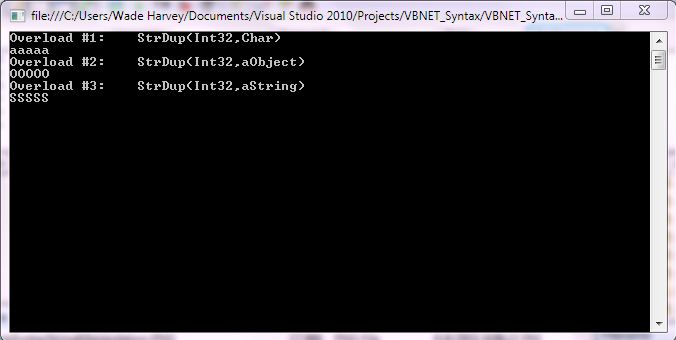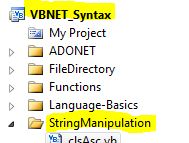*** 4. StrDup – Full Example ***
StrDup Example Output Screenshot

Step 1: Click Visual Basic to Cut-n-paste code into clsStrDup.vb
Public Class clsStrDup
Public Sub Main()
'****************************************************************************************
' Purpose: Returns a string or object consisting of the specified
' character repeated the specified number of times.
'
' Syntax: StrDup(Int32,Char)
' StrDup(Int32,Object)
' StrDup(Int32,String)
'
' Parameter1: Int32 - Required - number of times to dup the first
' character of the char, object, or string
'
' Parameter2: Char, Object, String - Required - Char, Object, or string
' that you want the first character dupped of.
'
' Result: string or object - Returns a string or object consisting of the specified
' character repeated the specified number of times.
'
' Quick Example: Console.WriteLine(StrDup(5, "a")) 'Returns aaaaa
'
'****************************************************************************************
'****************************************************************************************
' Overload #1: StrDup(Int32,Char) Returns a string or object consisting of the specified
' character repeated the specified number of times.
' Overload #2: StrDup(Int32,Object) Returns a string or object consisting of the specified
' character repeated the specified number of times.
' Overload #3: StrDup(Int32,String) Returns a string or object consisting of the specified
' character repeated the specified number of times.
'****************************************************************************************
Console.WriteLine("Overload #1: StrDup(Int32,Char) ")
Console.WriteLine(StrDup(5, "a")) 'Returns aaaaa
Dim aObject As New Object
aObject = "Object"
Console.WriteLine("Overload #2: StrDup(Int32,aObject) ")
Console.WriteLine(StrDup(5, aObject)) 'Returns OOOOO
Dim aString As String = "String!"
Console.WriteLine("Overload #3: StrDup(Int32,aString) ")
Console.WriteLine(StrDup(5, aString)) 'Returns SSSSS
'write blank line to make output easier to read
Console.WriteLine()
'Prevent console from closing before you press enter
Console.ReadLine()
End Sub
End Class |
Public Class clsStrDup
Public Sub Main()
'****************************************************************************************
' Purpose: Returns a string or object consisting of the specified
' character repeated the specified number of times.
'
' Syntax: StrDup(Int32,Char)
' StrDup(Int32,Object)
' StrDup(Int32,String)
'
' Parameter1: Int32 - Required - number of times to dup the first
' character of the char, object, or string
'
' Parameter2: Char, Object, String - Required - Char, Object, or string
' that you want the first character dupped of.
'
' Result: string or object - Returns a string or object consisting of the specified
' character repeated the specified number of times.
'
' Quick Example: Console.WriteLine(StrDup(5, "a")) 'Returns aaaaa
'
'****************************************************************************************
'****************************************************************************************
' Overload #1: StrDup(Int32,Char) Returns a string or object consisting of the specified
' character repeated the specified number of times.
' Overload #2: StrDup(Int32,Object) Returns a string or object consisting of the specified
' character repeated the specified number of times.
' Overload #3: StrDup(Int32,String) Returns a string or object consisting of the specified
' character repeated the specified number of times.
'****************************************************************************************
Console.WriteLine("Overload #1: StrDup(Int32,Char) ")
Console.WriteLine(StrDup(5, "a")) 'Returns aaaaa
Dim aObject As New Object
aObject = "Object"
Console.WriteLine("Overload #2: StrDup(Int32,aObject) ")
Console.WriteLine(StrDup(5, aObject)) 'Returns OOOOO
Dim aString As String = "String!"
Console.WriteLine("Overload #3: StrDup(Int32,aString) ")
Console.WriteLine(StrDup(5, aString)) 'Returns SSSSS
'write blank line to make output easier to read
Console.WriteLine()
'Prevent console from closing before you press enter
Console.ReadLine()
End Sub
End Class Step 2: Click Visual Basic to Cut-n-paste code into Module1.vb
Module Module1
Sub Main()
Dim myclsStrDup As New clsStrDup
myclsStrDup.Main()
End Sub
End Module |
Module Module1
Sub Main()
Dim myclsStrDup As New clsStrDup
myclsStrDup.Main()
End Sub
End Module Prerequistes:
- Install Visual Basic (Express or Standard Edition)
- Install SQL Server Express
- Download Northwind and pubs Database
- Attach Northwind Database to Databases in Sql Express
- Attach pubs Database to Databases in Sql Express
Notes:
- Console Application is used to simplify things, but Windows Forms or Web Forms could also be used
- You can build a library of syntax examples by using same project over and over and just commenting out what you do not want to execute in Module1.vb
Instructions:

- Use Visual Basic 2010 Express or Standard Edition
- Create new project;
- Click File/New Project
- Select Console Application Template
- Select Visual Basic for Language
- name of project could be VBNET_Syntax.
- Add New folder named “StringManipulation”
- Right-click project name in solution explorer;
- add new folder;
- name of folder could be: StringManipulation
- Add Class Named clsStrDup to StringManipulation folder
- Right-click StringManipulation folder;
- add new item;
- Select class
- Class name could be clsStrDup
- Click on Visual Basic in code in step 1 above to copy code into clsStrDup.vb
- Click on Visual Basic in code in step 2 above to copy code into Module1.vb
- Click green arrow or press F5 to run program
|
 Download Source Code for All VB Console Examples in One Project – source code for hundreds of VB.NET console examples neatly organized in a single project.
Download Source Code for All VB Console Examples in One Project – source code for hundreds of VB.NET console examples neatly organized in a single project.
